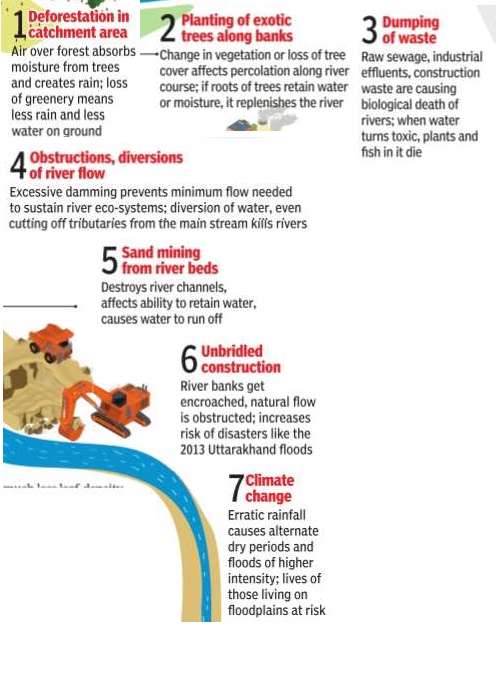Rivers: India (issues)
This is a collection of articles archived for the excellence of their content. |
The shrinking of Indian rivers


Water Available Per Person In A Year Has Reduced By Over Two-Thirds In Six Decades. And It's Getting Worse. Saving Water Is Not Enough, It's Time To Revive Our Lifelines
India has about 400 rivers. If laid end to end, their length adds up to nearly 2 lakh kilometres, enough to go around the earth five times or reach two-thirds of the way to the moon. They carry an enormous 1,869 billion cubic metres of water every year--enough to submerge the whole of India in nearly two feet of water. Embedded in history, this river network determines climate and geography , sustains 1.3 billion people and provides a mooring to their diverse cultures.
Why are rivers so important? A look at the water equation for the country will immediately show you. Imagine that 100 litres of water falls as rain over India. Some 53 litres is lost as it either evaporates directly or through plants and trees, or gets retained in soil. The remaining 47 litres flows into the rivers but only 28 litres is actually available because the rest is locked away in inaccessible places, or turns brackish. Of this 28 litres, 17 flows in the rivers and 11 ends up as rechargeable groundwater.
With growing population and its demands, this already insufficient water is becoming scarcer. In 1951, 5,200 cubic metres of water was available per person every year.This had dropped over two-thirds to just 1,545 cubic metres in 2011 and is projected to decline to 1,191 cubic metres by 2050.
So, rivers are becoming more and more important. Groundwater has its limits which are already being breached in many areas. Rainfall is becoming more erratic with climate change. Rivers remain a reliable source of life-giving water.
Yet, by all counts, India's fabled rivers are under dire threat. At a meeting of water activists and experts in December 2016 called India Rivers Week, information and ground reports from 290 rivers across the country were analysed and the verdict was chilling: 205 (over 70%) of them, including most of the big rivers, were in the critical or `red' category . Their water flows were diminished, tributaries were dwindling or cut off, pollution was rampant, river banks built up and encroached, and catchment areas denuded of forests.
THREAT TO RIVERS
“Most rivers are overexploited by constructing structures like check dams, weirs, dams, so the minimum flow (called `environmental' flow) required for the river eco-systems is not materialized. Studies show the current minimum flow is only one-third of what is required. Many small tributaries of the rivers are disconnected due to population pressure, road development etc.,“ K Palanisami, professor emeritus at the International Water Management Institute, told.
“Another factor for slow dying of the rivers is the rainfall pattern which has changed a lot in the recent years, thus making the river flows unsustainable. As a result, people start misusing them in terms of sand mining, encroachment, polluting,“ he added.
Himanshu Thakkar of the South Asia Network on Dams, Rivers and People (SANDRP) told that other factors damaging rivers included construction of hydropower projects, lack of understanding or appreciation of rivers and their roles, dumping of waste, climate change, riverfront development and destruction of biodiversity . “In India, dams and hydropower projects are possibly the biggest reasons for the destroyed threatened state of our rivers,“ he alleged.This is a controversial claim because there are many who say dams are necessary for meeting food and energy needs of a growing population. But water conservationists counter this by saying that a more sustainable path--with less wasteful consumption--was ignored.
FORESTS
Apart from pollution and diversion, one important factor that doesn't get that much attention is forests. Not only do forests help in making rain, they also act as pumps that draw in the rain-laden winds from the seas.
“Much of the rain that falls in some regions is moisture that has been returned to the atmosphere from locations downwind-and forests are particularly effective at providing such recycled moisture,“ Douglas Sheil, professor at Norwegian University of Life Sciences and associated with Center for International Forest Research, Indonesia, explained.
Forests also provide tiny particles like pollen and spores around which raindrops can condense, he said. Though forest cover has slightly improved in the past few decades, it is far less than it used to be earlier. Moreover, dense forest cover has declined to be replaced by open forest with much less leaf density .
Deforestation in catchment areas is particularly high leading to deprivation of water flows to rivers through run-offs.
In short, India's life-sustaining rivers are dying a slow death. A complete policy overhaul is needed to rejuvenate them. People of the country need to be involved in this endeavour, otherwise it will fail like interventions in the past.